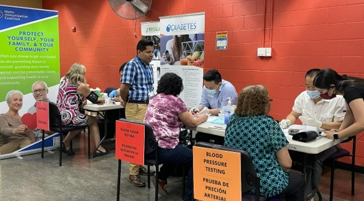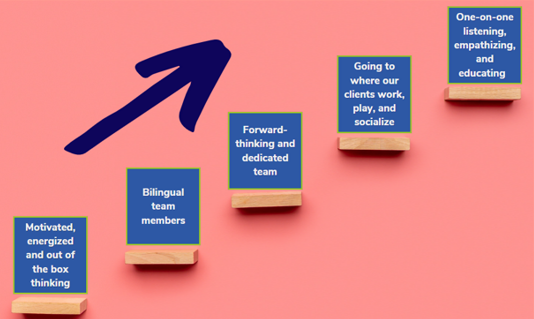COVID-19: The Leading Cause of Death for Idaho’s Hispanic Population
Health and social inequities contribute to the increased burden of COVID-19 among underserved communities and racial and ethnic minority groups, resulting in disproportionate rates of disease and inequitable access to testing, treatment, and vaccination opportunities.
To help ease this burden, the Idaho Immunization Coalition (IIC) has been traveling throughout Southern Idaho administering COVID-19 vaccines in rural areas since the summer of 2021. IIC’s primary focus has been on Idaho’s Hispanic and Latinx community, rural areas, and underserved populations. To promote immunization, the IIC conducted vaccine clinics and participated in conversations with community residents about vaccine information, while seeking to answer their questions and address any concerns.
Promoting Immunization
IIC‘s work is critical because, in Idaho, COVID-19 was the third leading cause of death overall in 2020 and 2021, and the leading cause of death among Hispanic persons in the state. Approximately 12% of Idaho’s residents are Hispanic, but Hispanics make up 16% of COVID-19 cases in the state.
Karen Sharpnack is the Executive Director of the IIC. She says when the organization began in 2012 it was mostly education based, but now it is very different. “We have three pillars to our organization – Public Outreach, Advocacy and Education,” she explains. “Advocacy means working at the state capitol during the Idaho Legislative session and supporting positive bills to be moved forward, stopping bills that may be harmful, and working with individuals and organizations to have one voice.”
Vaccination Obstacles
Idaho is a strong red state, Sharpnack explains, and the legislature has a super majority that is strongly in favor of parents’ rights when it comes to COVID vaccinations. Idaho is one of the least vaccinated states in the country in the uptake of COVID-19 vaccinations. As of the first week of May, 64% of the population has received at least one dose, while 57% of Idaho’s population has been fully vaccinated. Nationally 81% of the population has received at least one dose, while 70% is considered fully vaccinated.
Sharpnack says her organization obviously has had some challenges over the past 10 years. “We learned how to ignore the noise. I don’t want to say we don’t care; we just choose not to engage and focus on the positive actions to increase vaccination rates for all Idahoans. When we are engaging with any community, we begin with educating first about the vaccine and asking questions to have a better understanding of concerns one may have, which increases the relationship and builds trust. Over the years there have been times where our vaccine supporters, along with me, have been screamed at, sworn at and even threated.”
She adds, “We just won’t be quiet; we will find a way to get the word out. We also have access to four lobbyists who support our efforts, so we go behind the scenes to educate Legislators, as well as advocate for our vaccine champion stakeholders to write letters or call their individual Legislator and even testify at hearings. We’re still going to be out there; we are still going to be on billboards and every possible radio station you can think of sharing the importance of getting vaccinated. Our ultimate goal is; being up-to-date on your vaccinations will be the norm, not making this important preventative measure being political.”
The biggest challenge overall, Sharpnack says, “is being in a state that is 82% white, and whose population is not exactly totally onboard with getting vaccinated against COVID-19. If people don’t want you somewhere, they are going to let you know. There have been times we’ve been picketed, or anti-vax moms line up in a row so no one can get through to our education or vaccination table.”
In terms of the Hispanic population, the biggest challenge has been language. “We have found that most of the Hispanic families we have spoken to need a one-on-one, especially if they didn’t speak any English,” Sharpnack describes. “That is why we have two full-time Health Equity Coordinators and hired independent contractors to assist.”
Sharpnack continues to explain that “The other challenge was, at one point early-on, the IIC staff didn’t look like the people we were working with, so there was a huge trust issue. This is when we realized we needed to hire people who looked like the people we were trying to work with. We also built relationships with organizations like the Mexican Consulate, the Hispanic Cultural Center of Idaho, and the United Alliance of Southern Idaho. It’s all about building trust and relationships.”
Bringing Vaccines to the People
The IIC’s targeted audience is the Hispanic population because at this time there are COVID-19 state and federal funds available. Sharpnack explains, “When we do vaccination clinics, we are looking for Hispanics in underserved areas and rural communities. We also are wanting to help those out that may be in the shadows, meaning they may not be necessarily legal in this country. They may need more than just vaccinations, and may need additional resources such as healthcare, food, clothing, and a place to live.”
For the majority of the time that the IIC is not marketing or advertising these clinics, they very quietly go in without anyone knowing other than the organization or business. For example, Sharpnack says, “We may work with a dairy, and they have 50 employees and most of them are Hispanic. We will put a flyer together in English and Spanish. We’ll tell them we’re coming out, and we will make sure we not only have COVID-19 and flu available, but other adult vaccines, all at no cost. We typically also provide health screenings and have incentives to give away. Some incentives we have offered may be free lunch, $25 gift cards to a local grocery store, having food boxes available. We also encourage the whole family to attend. Again, this is very quietly being done.”
Over the past few years, the IIC has raised $5 million dollars to conduct health/vaccination clinics in the southern parts of Idaho targeting the Hispanic population, underserved and rural areas, with the majority of the funds available until June 2025. The IIC has numerous funding sources for this project, such as state and federal contracts, foundations, and individual donations. The bulk of the funding comes from a couple of state contracts.
Education and Health Screenings
In terms of education, the IIC conducts in-person immunization summits, webinars, radio and T.V. interviews; presents at state and national conferences; and educates on social media platforms. Sharpnack says, “We also do one-on-one conversations about COVID-19, and last year we had individual conversations with over 6,000 Hispanic people on the importance of getting vaccinated and answering their questions. Some examples are -- we canvass the community by door knocking before a vaccination clinic, we attend community events by exhibiting, we go to businesses and do education sessions for small groups, and are available on “Facebook lives” to educate and answer questions. We have bilingual employees and about a dozen independent contractors who are bilingual. We have them at every event, whether it is an educational event or if it is a health/vaccine clinic.”
What has really worked for the IIC has been the health screenings where the organization checked on cholesterol, blood glucose, and blood pressure. “All of a sudden there is trust because we have a bilingual person with us who has a medical background talking with them, and somehow, they are able to maneuver into ‘would you like a COVID shot, or a flu shot?’” Sharpnack says that over half the time they are able to talk community members into a vaccine or two. “That’s our secret sauce…it’s that trust we build on the spot, taking away barriers.”

Sparpnack adds that, “Our staff helps them with the paperwork because we have found that about 25% of the Hispanic people we work with don’t read or write, so that is a barrier we’ve been able to overcome when we ask them ‘do you need help with the paperwork? We make coming to a clinic very welcoming. We have anywhere from two to six bilingual staff working to help. It’s just a trust that we build.”
IIC uses its own van and can go anywhere and do a clinic for upwards of a thousand people. Currently they complete approximately 100 mobile health/vaccination clinics per year, meeting people in various community settings such as: churches, businesses, schools and universities, cultural centers, individual homes, and government entities.
Our Steps for Success
The most successful type of vaccine clinic IIC did is partnering with trusted community organizations. Prior to those vaccine clinics, they would go out in the community and talk to people about their COVID-19 vaccine questions and concerns. The IIC collaborated with school districts, nonprofits, food banks, and trusted sources in the communities. Throughout their outreach work, some of the concerns they heard were about the safety of the vaccine, needles, and misinformation on social media. Individually the IIC could take the time necessary to address the particular concerns that people had with myths and misinformation. Translators were also available to share the information in Spanish.

Listening is Important
The IIC uses focus groups, which they call listening/conversation sessions, to understand what people are thinking. The IIC organization may spend a Saturday at a local business, sometimes a hotel where the staff may be primarily Hispanic. Sharpnack says, “We want to hear from them. We pay them $50 to be a part of the group, and we also provide a meal. We ask them all sorts of questions regarding COVID, including ‘what myths have you heard?’” She adds, “The myths are just tremendous. You just kind of get yourself blown away.” Some of the myths they heard include, if you get the vaccine you will walk backwards for 20 minutes. Other myths included, I’m going to be sterile, and vaccines don’t work, you’re just poisoning yourself.
Sharpnack says, “We then ask if they have questions for us, and we bring in a well-known, well respected Hispanic doctor, and there aren’t many in Idaho, to hear and answer their questions. We then play 3-minute snippets of the correct information in English and in Spanish involving COVID-19 so they can hear the other side and so we can open up a discussion. The participants have an opportunity after the listening session to leave at the end of the session. We even pay them $50 for their time. But they stay. They could have easily walked out but they don’t. We don’t know if we changed minds, but at least we built that relationship.” They don’t do a vaccination clinic on that day because, Sharpnack says, then the interaction looks like a setup. They instead invite community members to their next clinic.
Teamwork is Vital
When asked about her biggest successes, Sharpnack points right to her team. “The team of employees that we have, the independent contractors, the people who conduct the health/vaccination clinics from the Idaho State College of Pharmacy are unbelievable. All of them are full of energy, have a positive attitude and always suggesting things. I’m really proud of how we have been able to be the trusted organization in the Southern part of the state. We’re really honing in on questions on how we can improve what we are doing and to increase our presence to have available the COVID-19 vaccine for the Hispanic population, underserved, and the rural areas of the southern part of Idaho. We know we are making a difference.”
Sharpnack says there is much work to be done to reach their goal of maximum immunization coverage in all populations. Her organization wants to create a culture of immunization that is largely accepted and supported statewide, breaking down barriers to maximum protection from vaccine-preventable disease.
For more about the IIC, read this story about their annual All Kings Day event.
